Nutmeg and mace
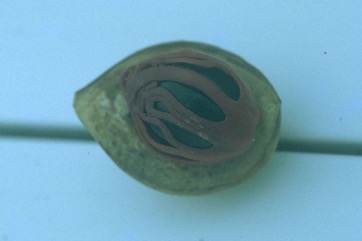
A tropical plant. It is native to Maluku in Indonesia. It suits hot humid tropical places and needs a fertile well drained soil. It grows in lowland areas and needs protection from wind. It cannot tolerate drought. It suits hardiness zones 11-12. At MARDI. In Yunnan.
Also known as:
Atong-ula, Buah pala, Chan thet, Jadikai, Jadipattiri, Jaiphal, Jajikai, Japatri, Jathi, Jatiphala, Jayapatri, Jotri, Misgadu, Muscade, Muscadier, Muskat, Muskatnuss, Nikuzuku, Noce moscata, Nootmuskaat, Nuez moscada, Pala, Rou dou kou, Sadikka, Sar-deik-bo-thi, Tau kau, Zadeik-po, Zalipho thi
Synonyms
- Myristica officinalis L. f.
- Myristica moschata Thunb.
- Myristica aromatica Lamk.
- Myristica amboinensis
Edible Portion
- Seeds, Aril, Herb, Spice
Where does Nutmeg and mace grow?
Found in: Africa, Andamans, Asia, Australia, Bangladesh, Bougainville, Brazil, Caribbean, Central America, China, Colombia, Cook Islands, Cuba, Dominican Republic, East Africa, Fiji, FSM, Grenada, Haiti, Hawaii, India, Indochina, Indonesia, Jamaica, Kiribati, Laos, Madagascar, Malaysia, Mauritius, Mexico, Micronesia, Myanmar, Nicaragua, Pacific, Papua New Guinea, PNG, Philippines, Pohnpei, Samoa, Sao Tome and Principe, SE Asia, Sierra Leone, Singapore, South Africa, Southern Africa, South America, Sri Lanka, Suriname, Taiwan, Tanzania, Thailand, United States, Vietnam, West Africa, West Indies
Notes: There are about 72 Myristica species. They grow in the tropics.
Status: It is a commonly cultivated and used spice.
Growing Nutmeg and mace
Cultivation: Trees are normally grown from seed. Seeds are slow growing. They can take 30 months to germinate. Plants can also be grown by cuttings and grafting. A spacing of 9 m apart is suitable. A ratio of a male tree to 10 female trees is used. Extra male trees are removed.
Edible Uses: The seed is used for the spice called nutmeg. This is used to flavour custards, sauces, cakes and pies. The red layer (aril) around the seed produces the spice called mace. It is used in soups, sauces, curries, fruit salads, cakes, pickles and baked goods. The outer shell of the fruit is sliced, cooked and crystallised to make a candy. It is also used for pickles. CAUTION The oil in the seed contains a poisonous drug called myristicin.
Production: Seeds take 3 months to germinate. Trees begin producing after 5-7 years. Trees can keep producing for 40 years. The mace is peeled away from the nutmeg and dried. When the nutmeg is dry it rattles.
Nutrition Info
per 100g edible portion| Edible Part | Energy (kcal) | Protein (g) | Iron (mg) | Vitamin A (ug) | Vitamin c (mg) | Zinc (mg) | % Water |
|---|---|---|---|---|---|---|---|
| aril- mace ground | 476 | 6.7 | 11.9 | 80 | 21 | 2.3 | 8.2 |
| Nuts-Nutsmeg ground | 525 | 36.3 | 3 | 10 | 3 | 2.2 | 6.23 |
Nutmeg and mace Photos

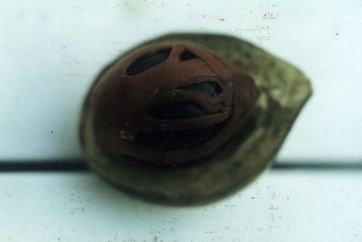
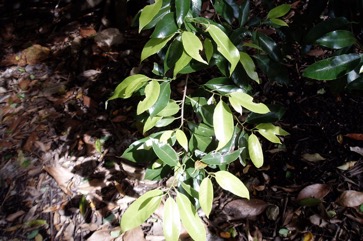
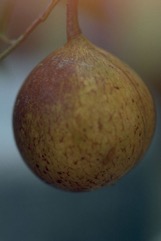
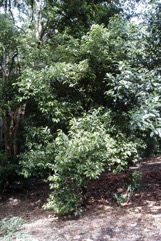
References
Ambasta, S.P. (Ed.), 2000, The Useful Plants of India. CSIR India. p 388
Ashton, M. S., et al 1997, A Field Guide to the Common Trees and Shrubs of Sri Lanka. WHT Publications Ltd. pdf p 286
Barwick, M., 2004, Tropical and Subtropical Trees. A Worldwide Encyclopedic Guide. Thames and Hudson p 291
Bianchini, F., Corbetta, F., and Pistoia, M., 1975, Fruits of the Earth. Cassell. p 212
Bodkin, F., 1991, Encyclopedia Botanica. Cornstalk publishing, p 715
Bremness, L., 1994, Herbs. Collins Eyewitness Handbooks. Harper Collins. p 68
Burkill, H. M., 1985, The useful plants of west tropical Africa, Vol. 4. Kew.
Chandrashekara, U. M., 2009, Tree species yielding edible fruit in the coffee-based homegardens of Kerala, India: their diversity, uses and management. Food Sec. 1:361-370
Cheifetz, A., (ed), 1999, 500 popular vegetables, herbs, fruits and nuts for Australian Gardeners. Random House p 140
Chin, H.F., & Yong, H.S., 1996, Malaysian Fruits in Colour. Tropical press, Kuala Lumpur p 43
Cobley, L.S. (rev. Steele, W.M.) 2nd Ed., 1976, An Introduction to the Botany of Tropical Crops. Longmans. p 244
Coe, F. G. and Anderson, G. J., 1999, Ethnobotany of the Sumu (Ulwa) of Southeastern Nicaragua and Comparisons with Miskitu Plant Lore. Economic Botany Vol. 53. No. 4. pp. 363-386
Esperanca, M. J., 1988. Surviving in the wild. A glance at the wild plants and their uses. Vol. 2. p 116
Etherington, K., & Imwold, D., (Eds), 2001, Botanica's Trees & Shrubs. The illustrated A-Z of over 8500 trees and shrubs. Random House, Australia. p 487
Facciola, S., 1998, Cornucopia 2: a Source Book of Edible Plants. Kampong Publications, p 157
Foreman, D.B., in Womersley, J.S., (ed), 1978, Handbooks of the Flora of Papua New Guinea. Melbourne University Press,Victoria. Vol 1, p 197
Flowerdew, B., 2000, Complete Fruit Book. Kyle Cathie Ltd., London. p 209
French, B.R., 1986, Food Plants of Papua New Guinea, A Compendium. Asia Pacific Science Foundation p 368
Gouldstone, S., 1983, Growing your own Food-bearing Plants in Australia. Macmillan p 174
Hedrick, U.P., 1919, (Ed.), Sturtevant's edible plants of the world. p 430 (Also as Myristica acuminata ?)
Hemphill, I, 2002, Spice Notes. Macmillan. p 259
Hutton, W., 1997, Tropical Herbs and Spices of Indonesia. Periplus. p 43
Hu, Shiu-ying, 2005, Food Plants of China. The Chinese University Press. p 399
Kiple, K.F. & Ornelas, K.C., (eds), 2000, The Cambridge World History of Food. CUP p 433, 1805, 1823
Kybal, J., 1980, Herbs and Spices, A Hamlyn Colour Guide, Hamlyn Sydney p 132
Lembaga Biologi Nasional, 1977, Buah-Buahan, Balai Pustaka, Jakarta. p 100
Macmillan, H.F. (Revised Barlow, H.S., et al), 1991, Tropical Planting and Gardening. Sixth edition. Malayan Nature Society. Kuala Lumpur. p 381
Martin, F. W., et al, 1987, Perennial Edible Fruits of the Tropics. USDA Handbook 642 p 39
Menninger, E.A., 1977, Edible Nuts of the World. Horticultural Books. Florida p 82
Miguel, E., et al, 1989, A checklist of the cultivated plants of Cuba. Kulturpflanze 37. 1989, 211-357
Moon, H. K., et al, 2010, Tropical Tree of Indonesia. Korea Forest Research Institute. p 189
Mulherin, J., 1994, Spices and natural flavourings. Tiger Books, London. p 58, 67
Nathan, A., & Wong Y Chee, 1987, A Guide to Fruits and Seeds, Singapore Science Centre. p 34
Nat. hist. 2(3):333. 1774
Ochse, J.J. et al, 1931, Vegetables of the Dutch East Indies. Asher reprint. p 523
Owen, S., 1993, Indonesian Food and Cookery, INDIRA reprints. p 76
Pham-Hoang Ho, 1999, An Illustrated Flora of Vietnam. Nha Xuat Ban Tre. p 281
Plants of Haiti Smithsonian Institute http://botany.si.edu/antilles/West Indies
Purseglove, J.W., 1968, Tropical Crops Dicotyledons, Longmans. p 391
Segura, S., et al, 2018, The edible fruit species in Mexico. Genet Resour Crop Evol (2018) 65:1767–1793
Smith, A.C., 1981, Flora Vitiensis Nova, Lawaii, Kuai, Hawaii, Volume 2 p 42
Smith, P.M., 1979, Nutmeg, in Simmonds, N.W., (ed), Crop Plant Evolution. Longmans. London. p 316
Solomon, C., 2001, Encyclopedia of Asian Food. New Holland. p 226, 253
Staples, G.W. and Herbst, D.R., 2005, A tropical Garden Flora. Bishop Museum Press, Honolulu, Hawaii. p 415
Sukarya, D. G., (Ed.) 2013, 3,500 Plant Species of the Botanic Gardens of Indonesia. LIPI p 407
Sukenti, K., et al, 2016, Ethnobotanical study on local cuisine of the Sasak tribe in Lombok Island, Indonesia. Journal of Ethnic Foods. 3 (2016) 189-200 p 198
Suwardi, A. B., et al, 2020, Ethnobotany and conservation of indigenous edible fruit plants in South Aceh, Indonesia. Biodiversitas Vol. 21, No. 5, pp 1850-1860
Tankard, G., 1990, Tropical fruit. An Australian Guide to Growing and using exotic fruit. Viking p 112
Tyagi, R. K., et al, 2004, Conservation of Spices Germplasm in India. Indian J. Plant Genet. Resour. 17(3): 163-174
van Wyk, B., 2005, Food Plants of the World. An illustrated guide. Timber press. p 259
Vickery, M.L. and Vickery, B., 1979, Plant Products of Tropical Africa, Macmillan. p 87
Whistler, W.A., 2004, Rainforest Trees of Samoa. Isle Botanica Honolulu, Hawaii. p 111
Williams, C.N., Chew, W.Y., and Rajaratnam, J.A., 1989, Tree and Field Crops of the Wetter Regions of the Tropics. Longman, p 229
World Checklist of Useful Plant Species 2020. Royal Botanic Gardens, Kew
www.worldagroforestrycentre.org/treedb/
Zawiah, N. & Othaman, H., 2012, 99 Spesies Buah di FRIM. Institut Penyelidikan Perhutanan Malaysia. p 172